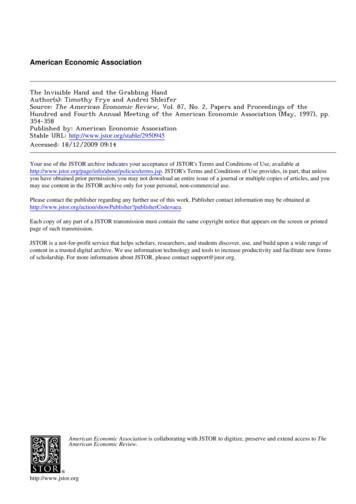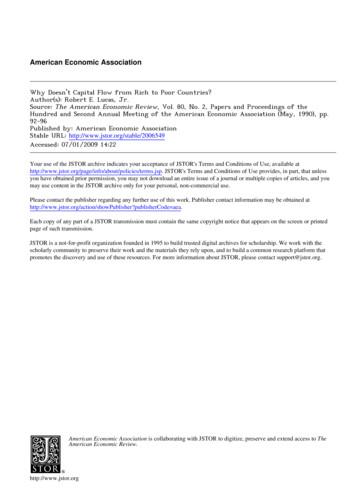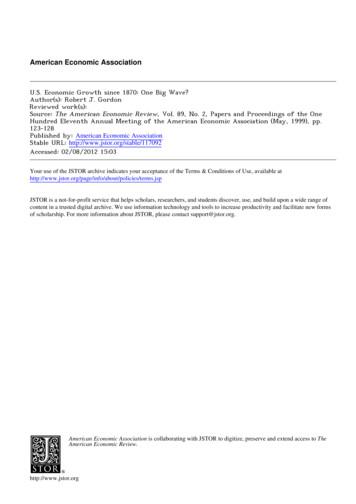AMERICAN MEDICAL ASSOCIATION MEDICAL EDUCATION
AMERICAN MEDICAL ASSOCIATIONMEDICAL EDUCATIONINNOVATION CHALLENGE2016 TEAM PROPOSALS
What does the medical school of the futurelook like to you?Launched as an extension of the American Medical Association’s “AcceleratingChange in Medical Education” initiative, our first-ever AMA Medical EducationInnovation Challenge asked medical students and students of other healthprofessions across the country to answer this very question.The response was enthusiastic and enlightening.We received nearly 150 submissions from student teams (comprised of twoto four students each) and were impressed with the ingenuity and originalitywith which each team tackled this question. The challenge dared students to“turn MedEd on its head” and think differently about their education. Creative,forward-thinking and bold, the innovations submitted not only reinforcedour confidence in tomorrow’s physicians, but they also made for a difficultdecision-making process when it came to determining winners.The AMA is very pleased to award one first-place prize ( 5,000), one secondplace prize ( 3,000) and two third-place prizes ( 1,000). In addition, werecognized 26 proposals with an honorable mention (noted throughout thisbook). Following the challenge, we asked each team to synthesize the highlights of its innovation in an abstract, 113 of which you will find captured inthe following pages.As you read through these abstracts, we hope you will recognize, as we did,the passion and unique perspective each student team brought to answeringour question. And just as we did, we hope you will appreciate the enthusiasmand see the promise in our next generation of physicians who are giving theirvoices to help transform the future of medical education in this country.Susan E. Skochelak, MD, MPHRichard Hawkins, MDGroup vice president, Medical Education, AMAVice president, Medical EducationOutcomes, AMA 2016 American Medical Association. All rights reserved. 16-0082:PDF:3/16
Grand prize winnersFIRST PLACEIn search of a “Muse”: An opennational exchange for theadvancement of medical educationUtrankar A 2018, Shenson JA 2016Vanderbilt University School of MedicineIdentified needIn the instant, open, participatory ecosystem of the Digital Age,medical education remains slow to change, siloed withininstitutions and over-reliant on passive learning. The forces ofacademic publishing, institutional isolation, and resourceconstraints on curriculum development restrict the diffusion ofinnovations in content and pedagogy as medicine evolvesexponentially. For a generation that must know and do morethan ever before, medical education must be collaborative,evenly distributed and adaptive.InnovationIdentified needWe want to foster creativity in medical education by enablingmedical students to become “makers” who prototype and designmedical devices. Health care professionals and studentsexperience pain points on a daily basis but are not given thetools, training or opportunity to help solve them. The physicianof the future, bolstered by in-situ problem-solving and makingskills, will be able to make a difference in the changing healthcare landscape.InnovationWe want to enable medical students to become tinkerers whoprototype and create solutions to problems in health carethrough collaborative workshops. The pre-clinical curriculumwould incorporate skills centered around (1) computer scienceand small electronics (CSSE), (2) textiles and medical materials(TMM), and (3) rapid prototyping technologies (RPT).Complemented by an on-campus makerspace, students will beable to prototype and iterate on their ideas in a fun andaccessible space.We envision “Muse,” an online national exchange—equal partsinformation repository, social network and learningmanagement system—where medical schools will publish theircurricular materials as free, open-access content for use byeducators and learners. Creative Commons licensure willfacilitate attribution, content adaptation and iteration. Systemsfor search, post-publication peer review, learner feedback andsocial metrics will surface and scale the strongest content,accelerating diffusion of innovations and reducing redundancy.ImplicationsImplicationsContactMuse empowers medical schools to continually discuss, shareand strengthen content in a “living curriculum” that evolveswith changing medical science and practice. It enables faculty toredirect efforts from developing redundant content to selectingthe strongest content, then supplementing it with activelearning approaches that promote comprehension andretention. It allows emerging schools to launch at lower cost andensures learners are well-prepared to navigate medicine’schanging @vanderbilt.eduKeywordsmedical education, education technology, open access,information management, social networkingDesigning and making with patients and health careprofessionals would change the current dynamic of medicaleducation, making students feel empowered to solve problemsin health care even at an early stage in their careers. In doing so,they will gain empathy, problem-solving abilities andcommunication skills that will extend into clinical practice. Ourproposed curriculum will equip medical students with the skills,passion and curiosity to impact the future of health care.Keywordsmaking, makerspace, innovation, design, prototypingTHIRD PLACEHappy healers, healthy humans: Awellness curricular model as ameans of effecting cultural change,reducing burnout and improvingpatient outcomesDeshmukh A 2018, Neal M 2018, Ruberg M 2018, Yared K2018University of Louisville School of MedicineSECOND PLACEDesign-thinking, making andinnovating: Fresh tools for thephysician’s toolboxBober T 2018, Albala L 2018, Koeneke-Hernandez L 2018,Mallozzi M 2018Sidney Kimmel Medical College at Thomas JeffersonUniversityIdentified needTraditional medical education emphasizes the efficient transferof ever-expanding bodies of scientific and clinical information tostudents. Although aspects of professionalism are addressed to
varying degrees, the important skills of self-awareness,communication and empathy are neglected. Physicians who lackthese skills are more susceptible to burnout. Given the negativeimpact of burnout on patient care, this is a problem that needsto be addressed.InnovationStudent goal-setting groups, reflection groups, cognitivebehavioral therapy training, and “The Healer’s Art” course willdevelop self-awareness, self-care and coping skills.Communication skills and compassion will be cultivatedthrough frequent pre-clinical patient interactions. Facilitydesign will make healthy choices easy for students and faculty.To address the hidden curriculum and propagate a positivelearning culture, wellness activities will be incentivized, andfaculty will be trained in mentoring and wellness.ImplicationsParticipant health and wellness data will be collected at regulartime points to gauge the efficacy of the program. The data alsohelps students and faculty track personal progress and addresshealth problems empirically. These innovations will reduce theincidence of physician burnout while increasing physician selfawareness, communication skills and empathy. These qualitieswill ultimately improve patient satisfaction and outcomes andwill contribute to a culture of compassionate , compassion, wellness, curriculum, educationhealth, including the built environment, access to care andprovider biases.ImplicationsA service learning medical curriculum will provide medicalstudents with a deeper understanding of the social determinantsof health and equip them with the tools to apply this perspectiveto their medical practice. This will benefit communities thatsuffer from health disparities by motivating a new generation ofculturally competent patient advocates who seek to understandand treat each individual within the context of their life shealth disparities, service learning, cultural competency,education, community healthOther submissionsThe community and homelessnessintegrated medical experience(CHIME)Adamo M 2018, Smith M 2016, Lu A 2018, Shah M 2018The Warren Alpert Medical School of Brown UniversityIdentified needTHIRD PLACECommunity and classroomapproaches to cultural competencyand health equityPlatt C 2019, Paprocki N 2019Midwestern University/Chicago College of OsteopathicMedicineIdentified needHealth disparities by race, ethnicity and socioeconomic statushave remained intractable despite many targeted public healthinitiatives. Though entering medical students identify healthdisparities as a barrier to positive health outcomes, the standardmedical school curriculum does not address health disparities ina comprehensive manner. As such, graduating medical studentsare ill prepared to preempt, identify and address factorscontributing to poor health among at-risk populations.InnovationWe propose that medical schools institute intentional, four-year,community-based service learning experiences, beginning in thefirst year of medical school. A service learning curriculum,designed in collaboration with community partners, will exposemedical students to local underserved communities, provideopportunities for longitudinal relationship building, and helpstudents reflect upon structural and individual determinants ofAMA Medical Education Innovation Challenge: 2016 Team ProposalsWithout changes to how future professionals are taught toconceptualize issues of homelessness and to interact withindividuals experiencing it, our health care system will continueto underserve this community. Medical education can do moreto shape practitioners who are able to both provide competent,individual-level care and engage effectively on a systems levelaround issues related to the social determinants of health.InnovationCHIME is comprised of the following components: (1) weeklyinterdisciplinary classes with social work students and membersof the homeless community to discuss policy and practiceimpacting homeless individuals with a focus on medicine withina social justice framework; (2) monthly street outreach withcommunity partners, social workers and medical providers; (3)engagement in a longitudinal community project; (4)completion of an independent project.ImplicationsCHIME will expose students to a unique fount of knowledge andperspective not yet adopted by many experienced providers.This creates a meaningful opportunity for students to educateand inform their seniors and, thereby, impact the quality of carefor homeless and underserved patients. Students armed withearly exposure to community medicine and social determinantsimpacting health can champion efforts to promote systemicchange and advocacy during their clinical experiences.2
Contactmeredith adamo@brown.eduKeywordshomelessness, advocacy, social determinants of health,outreach, interdisciplinary educationHONORABLE MENTIONPhysician citizens: The future ofmedicineAgrawal S 2018, Geiger C 2018, Vagasi A 2018Medical College of Georgia – AU/UGA Medical PartnershipIdentified needWe are the beneficiaries of our medical school’s problem-basedlearning curriculum, but one aspect of promoting health stillneeds attention: physician citizenship. A physician citizenadvocates for and participates in improving the socialdeterminants of health in our communities. While medicalschool curricula include projects to address advocacy and publichealth, much more can be done to integrate this importantaspect of health care into our education as physicians.InnovationWe have created a longitudinal curriculum lasting all four years.The pre-clinical years are spent learning the foundation ofphysician advocacy while the clinical years are spent applyingand honing those skills. We want to create medical graduateswith advocacy skills that are as second nature to every physicianas taking a history and physical.ImplicationsOur ultimate goal is to reach the point where advocacy becomesthe new status quo, and physicians translate the findings ofresearch into ways to improve community health outcomes andtake collective action to address social problems. Our proposedcurriculum integrates these goals into all four years of medicalschool. It is crucial for us to foster the relationship betweenscientific evidence, medicine, politics and community.Contactcgeiger@gru.eduKeywordsphysician citizen, advocacy, innovation, medical educationMedical education enhanced byaugmented realityAllan K 2022, Ghodasara S 2018, Rieth G 2018, Russell E2018Case Western Reserve University School of MedicineIdentified needBased on a survey of students at Case Western ReserveUniversity School of Medicine, we found a disconnect betweenstudents’ enthusiasm for learning about medicine and theirAMA Medical Education Innovation Challenge: 2016 Team Proposalsviews on medical education. Currently, students find medicaleducation to be tedious and scattered, and it fails to accuratelyreflect the practice of medicine.InnovationWe propose using Microsoft’s augmented reality device, theHoloLens, to make learning medicine more interactive andrealistic. We can generate an infinite number of patientscenarios in an enhanced problem-based learning format to helpmedical students gain realistic experience in the pre-clinicalyears of medical school. These scenarios can simulate patients’emotional states, normal and abnormal physical exam findings,conversations with patients and much more.ImplicationsWith the use of patient scenarios and the aid of the HoloLens,medical students will have more practical patient interactionexperiences in the pre-clinical years, ultimately making themmuch better prepared for practicing medicine in the real world.Additionally, the HoloLens can revitalize medical education,better aligning it with medical students’ inherent enthusiasm forlearning.Contactsdg46@case.eduKeywordsaugmented reality, simulation, evaluationHONORABLE MENTIONCommunity adoption in medicaleducation: Living with and learningfrom those we will one day serveAndrie J 2016, Cooper C 2017Penn State College of MedicineIdentified needMedical education must adapt to produce physicians capable ofmeeting the needs of our evolving health care system. Yet, ascare shifts towards the ambulatory setting, medical educationremains rooted in large academic institutions. Socialdeterminants of health are absent in many curricula but greatlyimpact health and disease. Medical school tuition hasskyrocketed, just one of many factors driving students to choosesub-specialty careers over much-needed primary carespecialties.InnovationThe community adoption model is designed to providecontextual learning for students through the collaborativeexchange of ideas and resources between a medical school and acommunity. A medical school would sponsor several communitycampuses, each with a distinct concentration on a particularpopulation. Population health would be taught through the lensof each community. Curricular innovations include acommunity advisor for each student, a community professorshipinitiative and longitudinal community-based experience.3
ImplicationsKeywordsCommunity adoption allows medicine to be learned in thecontext in which it will be applied and allows students toappreciate how community resources positively and negativelyimpact health. Implementation of technology decreases the costof education through utilization of online and pre-recordedresources. Creating multiple campuses in diverse communitiesallows medical education to be individualized according to thecareer trajectory and personal interests of each student.interprofessionalism, longitudinal, education, simulation, safetyContactAugustin, R 2018, Seth D 2018Case Western Reserve University School of Medicinejandrie@hmc.psu.eduKeywordscommunity adoption, population health, primary care,individualized education, contextual learningLongitudinal experience ininterprofessionalism: Education,clinical simulation and rotationArgo C 2018, Bayne D 2016, Hageman S 2018, Schenk S2016University of Nebraska Medical Center College of MedicineIdentified needMultiple suboptimal and poor patient outcomes have beenlinked to poor teamwork and communication, which hasprompted a renewed national interest in interprofessionaleducation. Despite this knowledge, the traditional medicalschool curriculum is typically a silo-structured,monodisciplinary education wherein interprofessionalcollaboration is not directly taught or practiced. Physiciansshould come out of training with the knowledge and skillsnecessary to become competent clinicians as well as effectivemembers of multidisciplinary teams.InnovationWe propose a longitudinal program for interprofessionalengagement in three phases—education, clinical simulation andclinical rotation. Pre-clinical students learn about the roles ofhealth care team members via shadowing, panel discussions ore-modules, then work through patient cases with aninterdisciplinary student group, progressing from cases onpaper to electronic health records and simulation. Finally,students in their final training months apply experiences to reallife patient care in a strongly interprofessional setting.ImplicationsStudent confidence and competency in a team environmentwithin existing systems would be improved through theseexperiences. High-quality interprofessional practice deliversmore cost-effective care and has been shown to enhance patientsafety, decrease errors, and improve both patient and healthprofessional satisfaction.ContactHONORABLE MENTIONCaseMed Minute—on-demand videosto reincorporate faculty into 21stcentury medical educationIdentified needThe class of 2019 is immersed in social media, spends more timewith mobile devices than any other informational medium andis required to trek through an increasingly immense volume ofmaterial throughout the standard four years of medical school.One can conclude from these observations that today’s medicalstudent requires incredible efficiency, has a naturally evolvedshorter attention span and receives a majority of information viaonline resources.Innovation“CaseMed Minute” has been established to (a) re-incorporatefaculty into today’s medical school and (b) establish a formatthat is not only conducive but also adaptable to the learningprocess of current students. Through surveys, CaseMed Minuteidentifies topics that are difficult for students and, then,identifies a faculty member who can address those topics. ACaseMed Minute member meets with the professor to create aninteractive video using drawings and slides via the iPad app“Explain Everything”.ImplicationsThe videos are made to be efficient and clinically relevant andare posted on YouTube and Facebook for easy online access.CaseMed Minute is reducing barriers between faculty andstudents, creating an efficient space of learning amidst thevolume overload of medical school and passing on resources formany students to come. We are creating a resource that is trulypersonalized—made according to student demand, available ondemand. This is medical education of the , high-yield, videos, on-demand, social mediaCollapsing the curriculum: Clinicalintegration, critical theory andmultidisciplinary perspectivesBaker R 2018, Garcia-Sampson L 2018, Richardson E 2018,Tsai J 2018The Warren Alpert Medical School of Brown Universitysara.schenk@unmc.eduAMA Medical Education Innovation Challenge: 2016 Team Proposals4
Identified needInnovationThis proposal aims to address intersecting health care issuesincluding poor care coordination, health disparities, overtreatment and inadequate preventive approaches to health.Biomedical content memorization is often emphasized aboveclinical skills and interdisciplinary approaches, hinderingmedicine’s ability to respond to the dynamic needs of itscommunities. Medical education should better integratescientific conte
What does the medical school of the future look like to you? Launched as an extension of the American Medical Association’s “Accelerating Change in Medical Education” initiative, our first-ever AMA Medical Education Innovation Challenge asked medical students and students of other health pro
AGMA American Gear Manufacturers Association AIA American Institute of Architects. AISI American Iron and Steel Institute ANSI American National Standards Institute, Inc. AREA American Railway Engineering Association ASCE American Society of Civil Engineers ASME American Society of Mechanical Engineers ASTM American Society for Testing and .
Iowa Chapter, American Academy of Pediatrics Iowa Dental Association Iowa Department of Public Health Iowa Health Care Association Iowa Hospital Association Iowa Medical Society Iowa Nurses Association Iowa Pharmacy Association Iowa Veterinary Medical Association Iowa‘s Statewide Epidemiology Education and Consultation Program State Hygienic .
377 amera realty co 378 ameracorp inc 379 american artist guild inc 380 american brake sv in 381 american brake sv of ga inc 382 american cheerleading inc 383 american general finance 384 american mkt & sales 385 american nail 386 american nail 387 american savings/ln 388 american welding 389 ameriquest technologies inc 390 amerivest mortgage co
American Economic Association The Invisible Hand and the Grabbing Hand Author(s): Timothy Frye and Andrei Shleifer Source: The American Economic Review, Vol. 87, No. 2, Papers and Proceedings of the Hundred and Fourth Annual Meeting of the American Economic Association (May, 1997), pp. 354-358 Published by: American Economic Association
American Economic Association The Peculiar Economics of Bureaucracy Author(s): William A. Niskanen Source: The American Economic Review, Vol. 58, No. 2, Papers and Proceedings of the Eightieth Annual Meeting of the American Economic Association (May, 1968), pp. 293-305 Published by: American Economic Association
American Economic Association Why Doesn't Capital Flow from Rich to Poor Countries? Author(s): Robert E. Lucas, Jr. Source: The American Economic Review, Vol. 80, No. 2, Papers and Proceedings of the Hundred and Second Annual Meeting of the American Economic Association (May, 1990), pp. 92-96 Published by: American Economic Association
American Economic Association U.S. Economic Growth since 1870: One Big Wave? Author(s): Robert J. Gordon Reviewed work(s): Source: The American Economic Review, Vol. 89, No. 2, Papers and Proceedings of the One Hundred Eleventh Annual Meeting of the American Economic Association (May, 1999), pp. 123-128 Published by: American Economic Association
Advanced Engineering Mathematics E Kreyszig; Wiley; 2001 4. Calculus, R A Adams; Pearson; 2002. Calculus (6th Edition) E W Swokowski, M Olinick, D Pence; PWS; 1994. MT1007 Statistics in Practice Credits 20.0 Semester 2 Academic year 2019/20 Timetable 11.00 am Description This module provides an introduction to statistical reasoning, elementary but powerful statistical methodologies, and real .






















